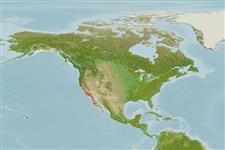Teleostei (teleosts) >
Perciformes/Cottoidei (Sculpins) >
Cottidae (Sculpins)
Etymology: Clinocottus: Greek, klinein, kline = sloping and bed, due to the four apophyses of sphenoid bone + Greek, kottos = a kind of fish (Ref. 45335).
More on author: Girard.
Environment: milieu / climate zone / depth range / distribution range
Ecology
Marine; demersal; non-migratory; depth range 0 - 18 m (Ref. 2850). Subtropical
Eastern Central Pacific: Cape Mendocino in northern California, USA to central Baja California, Mexico.
Size / Weight / Age
Maturity: Lm ? range ? - ? cm
Max length : 18.0 cm TL male/unsexed; (Ref. 2850)
Facultative air-breathing (Ref. 126274); A resident intertidal species with homing behavior (Ref. 32612). Often among intertidal algae. May leave tide pools if aquatic conditions become inhospitable (Ref. 31184). Breathes air when out of water (Ref. 31184).
Life cycle and mating behavior
Maturities | Reproduction | Spawnings | Egg(s) | Fecundities | Larvae
Eschmeyer, W.N., E.S. Herald and H. Hammann, 1983. A field guide to Pacific coast fishes of North America. Boston (MA, USA): Houghton Mifflin Company. xii+336 p. (Ref. 2850)
IUCN Red List Status (Ref. 130435)
Threat to humans
Harmless
Human uses
Tools
Special reports
Download XML
Internet sources
Estimates based on models
Preferred temperature (Ref.
123201): 12.4 - 25.8, mean 17.9 °C (based on 101 cells).
Phylogenetic diversity index (Ref.
82804): PD
50 = 0.5312 [Uniqueness, from 0.5 = low to 2.0 = high].
Bayesian length-weight: a=0.00776 (0.00420 - 0.01434), b=3.17 (3.00 - 3.34), in cm total length, based on LWR estimates for this species & (Sub)family-body (Ref.
93245).
Trophic level (Ref.
69278): 3.1 ±0.3 se; based on diet studies.
Generation time: 5.2 ( na - na) years. Estimated as median ln(3)/K based on 2
growth studies.
Resilience (Ref.
120179): High, minimum population doubling time less than 15 months (K=0.21-0.5).
Fishing Vulnerability (Ref.
59153): Low to moderate vulnerability (25 of 100).
